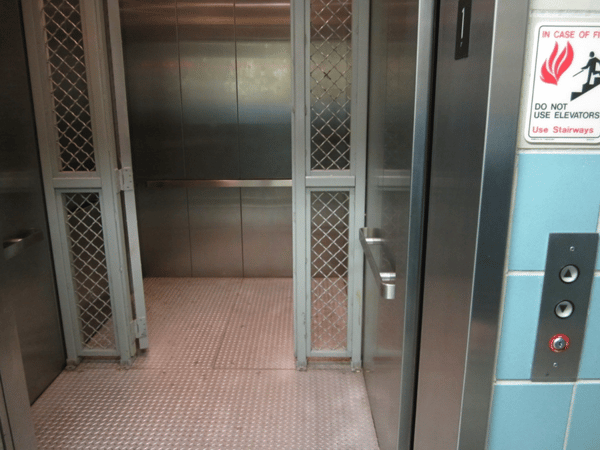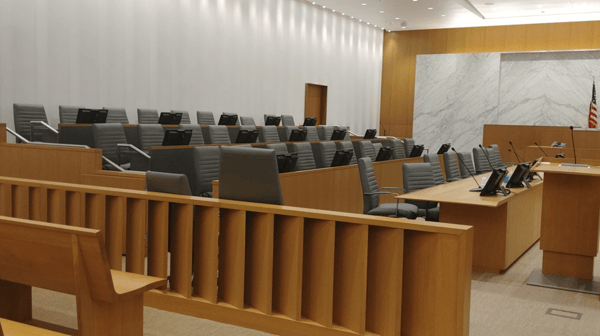Multi-defendant criminal court proceedings are a frequent occurrence in some court jurisdictions and may become increasingly prevalent due to gang or drug prosecution initiatives. If a court anticipates conducting proceedings involving multiple in-custody defendants, it is important the courthouse infrastructure includes prisoner facilities and provisions capable of properly handling such proceedings. Features of a courthouse that are important to the smooth operation of a multi-defendant court proceeding start from the prisoner unloading area and extend all the way to the courtroom. These features include the prisoner sallyport, prisoner elevator, central cellblock, courtroom holding cells, and (in some jurisdictions) a multi-defendant courtroom in your courthouse planning.
Sallyport
The general purpose of the sallyport is to safely load and unload prisoners when transported by vehicle from a jail or detention center to the courthouse. For the sallyport to properly accommodate multiple defendants who may all be presented to the courthouse for the same proceeding, the sallyport should be at least large enough to accommodate prisoner transport vans. Being able to use these larger vans can reduce or eliminate the need for multiple trips from the detention center or the need for multiple vehicles. Buses are also sometimes needed to accommodate busy court days.
Needless trips or an unnecessary number of prisoner transport vehicles increases the risk of a potentially dangerous incident and the amount of manpower needed for secure prisoner movement.
Prisoner Elevator
Similarly, the prisoner elevator should be large enough to accommodate several inmates in order to reduce the number of elevator trips. A prisoner elevator should have a large, caged area that segregates prisoners from law enforcement officers.

Prisoner Elevator with Cage
Central Cellblock
The central cellblock – or courthouse lockup – is the place where prisoners are initially held while awaiting court appearances and where they are held after those proceedings as they await transportation back to a detention center. It is important for the central cellblock to be large enough to accommodate the potential number of defendants for a multi-defendant proceeding, as well as other in-custody defendants for other court proceedings occurring on the same day. There should also be separation cells for groups of inmates who need to be kept separate from others, and isolation cells for prisoners who should not have any contact with other prisoners.
If a central cellblock lacks enough cells, or lacks separation or isolation cells, then courtroom holding cells (which are generally adjacent to the courtrooms) could be temporarily used for these purposes.
For jurisdictions that deal with multiple arraignments on any given day, it is useful to also have one large bullpen-type cell capable of holding multiple inmates awaiting arraignment on separate charges.
Courthouse lockups usually include attorney-prisoner interview rooms where individual inmates could meet with their attorneys. Another consideration is providing an interview space where several defendants in a single matter before the court – and who share an attorney – could jointly meet with their attorney. This can be accomplished through the use of a large, attorney-prisoner interview room that can accommodate several inmates.

Multiple Prisoner Interview Room
Courtroom Holding Cells
Courtroom holding cells are located next to courtrooms and house prisoners before or during a trial when the prisoners need to remain in close proximity to the courtroom. For a multi-defendant proceeding, it can be a difficult and risky task to simultaneously move several prisoners to the central cellblock during recesses and other short breaks in the proceedings. Thus, courtroom holding cells are extremely important.
It’s good practice to have at least two courtroom holding cells available for (1) accommodating a large number of defendants who may not fit in one cell, and (2) separating defendants who should not have contact with each other. If two cells are not enough, other holding cells designated for other courtrooms could be used if secure access to them is provided.
Multi-Defendant Courtrooms
I was recently in a courthouse in California that included a special courtroom for multiple defendants. The courtroom features a large box, similar to a jury box but designed to hold defendants. The multi-defendant box is on the opposite wall from the jury box and has seating for approximately 15 defendants along with their attorneys. The box is designed with a front panel so the jury cannot see leg shackles on prisoners who need to be restrained. The front panel also extends high enough that arm restraints are not visible to jurors.

Multi-Defendant Courtroom Box
In many jurisdictions, a courtroom is set aside to handle the procession of defendants brought before a judge for arraignment proceedings. While this situation is different in that there are not multiple defendants in the courtroom all involved in the same proceeding, some of the same considerations apply. It would be best to locate the arraignment courtroom in close proximity to the courthouse central lockup for ease of presenting in-custody defendants to the courtroom. As previously noted, a bullpen-type holding cell in the lockup should be provided for defendants awaiting arraignment. An option for the staging of defendants awaiting arraignment might be the use of a defendant box in the arraignment courtroom, similar to the one described above.
Getting Ahead of the Trend
With the rise of gang cases and large drug cases involving numerous defendants, it is important to make sure your courthouse is equipped with the features and facilities needed to make dealing with multiple prisoners a smooth, safe, and efficient operation.




.jpg)
.jpg)
.jpg)
.jpg)
.jpg)
.jpg)


-1.jpg)
.jpg)
.jpg)

